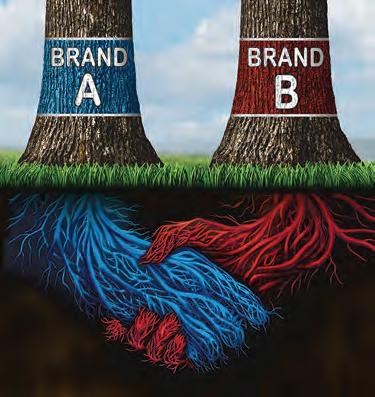
19 minute read
2.2 The nature of perfectly competitive and other types of markets in an economy
The production possibility diagram
Economists use the production possibility diagram (PPD) to illustrate the consequences of making alternative production choices or economic decisions.
Advertisement
a. Use Table 1.5 to accurately draw and fully label a PPD showing a hypothetical PPF for North Korea in 2023 (Note: all values are hypothetical). Assume North Korea can produce only two products: rice and defence equipment. Use your laptop or graph paper and then start by selecting appropriate scales for each axis. (3 marks) b. Use Table 1.5 to calculate the potential total level of national output (measured only in millions of units) for each of the following production possibilities or choices: A, B, C and D. (1 mark) TABLE 1.5 North Korea’s hypothetical production possibilities, 2023 Production possibilities Production choice (million units) A B C D Production of rice per year 0 25 32.5 40 Production of defence equipment per year 5 4 3 0 Calculate the country’s annual total output c. Identify three possible factors that hypothetically might help to shift North Korea’s PPF outward and to the right. Explain how this shift in the PPF might affect living standards. (3 marks) Question 4 (9 marks) The three-sector circular flow model a. Neatly draw and fully label a diagram representing a simple tthree-sector circular flow model of Australia’s economy. (5 marks) b. In some recent years, the rate of growth in the total level of spending by Australian households slowed down. Using the circular flow model that you have drawn, and assuming no change in government taxes or spending, clearly and systematically explain (i.e. logically, step by step) the macroeconomic effects of this spending slowdown in the Australian economy. (4 marks) Question 5 (7 marks) The business cycle a. Accurately define what is meant by the business cycle. (1 mark) b. Neatly draw and fully label a typical business cycle diagram showing different levels of national economic activity. (4 marks) c. Outline three important ways a period of boom might differ from a period of recession. (2 marks) Question 6 (14 marks) Consumer behaviour You have just decided to purchase a new pair of jeans. a. Identify and outline the key factors that economists traditionally believed would affect your decision (as a UNCORRECTED PAGE PROOFS consumer) to buy this pair of jeans. (4 marks)
b. Distinguish between incentives and disincentives, giving an example of each.
(2 marks)
c. Incentives and disincentives are used by parents, schools, employers and governments.
i. Explain how the government could discourage underage drinking. (2 marks) ii. Supporting charities is beneficial. Explain how the government encourages this support. (2 marks) iii. You have a part-time job at McDonald’s. Outline two strategies that your employer might use to alter your behaviour. (2 marks) iv. Schools often use prizes and detentions to affect student decisions. Outline the thinking behind these strategies. (2 marks)
Question 7 (7 marks) Business behaviour
a. BHP has been very successful and is one of Australia’s biggest mining companies. i. Outline the traditional viewpoint driving key business decisions by BHP. (2 marks) ii. Outline how the government might do each of the following: • discourage BHP from harming the environment through the release of CO2 emissions • encourage BHP to employ young unemployed workers and apprentices thereby reducing unemployment. (2 marks) b. Classify each of the following as either an incentive or disincentive, giving a brief explanation of your reasons: i. Tobacco companies operating in Australia are required by law to use plain packaging. (1 mark) ii. Businesses employing older Australians may be eligible for a government subsidy of up to $10 000. (1 mark) iii. Community award certificates are presented to those businesses involved in community work. (1 mark) Hey Teachers! Create custom assignments for this topic
Create and assign unique tests and exams Access quarantined tests and assessments

Track your students results Find all this and MORE in jacPLUS UNCORRECTED PAGE PROOFS
2Decision making in markets
UNIT 1 AREA OF STUDY 2 Decision-making in markets OUTCOME 1 On completion of this unit the student should be able to explain the role of relative prices and other non-price factors in the allocation of resources in a market-based economy, and analyse the extent of competition in markets. LEARNING SEQUENCE 2.1 Overview .................................................................................................................................................................68 2.2 The nature of perfectly competitive and other types of markets in an economy .......................69 2.3 BACKGROUND KNOWLEDGE: How markets make key economic decisions — the big picture ......................................................................................................................................................................77 2.4 The law of demand and movements along the demand curve ......................................................... 80 2.5 The law of supply and movements along the supply curve ................................................................83 2.6 Determining the market equilibrium price and equilibrium quantity ................................................86 2.7 The effects of non-price factors on demand and supply — shifting the D–S curves and changing the equilibrium price and quantity .............................................................................................88 2.8 How changes in relative prices and profits affect Australia’s resource allocation ...................100 2.9 Researching a contemporary Australian or global market ................................................................106 2.10 Review ...................................................................................................................................................................126 UNCORRECTED PAGE PROOFS

Hey students! Bring these pages to life online
Watch videos Engage with interactivities Answer questions and check results
Find all this and MORE in jacPLUS
2.1.1 Introduction A nation’s economy is simply an institution or organisation that coordinates the production and distribution of goods, services and incomes. As we know from our earlier studies (topic 1), Australia has a mixed economy (also called a predominantly market-based economy or contemporary market economy). Here, the three basic economic questions (i.e. what, how and for whom to produce) are generally answered by reference to the market or price system, where consumer sovereignty, competition, price incentives, the private sector and selfinterest are important features. Additionally, our economy also involves some government intervention to correct instances of market failure and other weaknesses of a pure market system. Our focus for this topic is to drill down to gain a deeper understanding of how different types of markets operate to allocate our limited resources amongst competing uses. This involves the study of microeconomics. We will come across the demand–supply diagram representing a single market. Here, demand by consumers and supply by producers interact to determine the equilibrium market price and quantity traded. But let’s not get too far ahead of ourselves just yet. FIGURE 2.1 Traditionally, markets took place in a particular location where buyers and sellers would meet face to face and negotiate prices through a process of offer and counteroffer. Increasingly, markets are conducted online and may not involve direct contact between buyers and sellers. UNCORRECTED PAGE PROOFS



KEY KNOWLEDGE
Use each of the following points from the VCE Economics Study Design as a heading in your summary notes. • the assumptions of a perfectly competitive market system • the law of demand and the demand curve • the effect on demand and the position of the demand curve by non-price factors, including changes in disposable income, the prices of substitutes and complements, tastes and preferences, interest rates, population and demographics, and consumer confidence • the distinction between a movement along the demand curve and a shift of the demand curve • the law of supply and the supply curve • the effect on supply and the position of the supply curve by non-price factors, including changes in the costs of production, technology, productivity, and climatic conditions and other disruptions • the distinction between a movement along the supply curve and a shift of the supply curve • the effects of changes in demand and supply on equilibrium prices and quantities • the role of the market mechanism and relative prices in the allocation of resources in a market-based economy • the degree of market power in different markets such as perfect competition, monopolistic competition, oligopoly and monopoly, and the effect on prices, resource allocation and living standards • the strategies businesses may use to increase profit, including price discrimination, multiple branding or anti-competitive behaviour, as outlined in the Competition and Consumer Act 2010 • one contemporary example of a market, including the degree of competition in that market. KEY SKILLS • define key economic concepts and terms and use them appropriately • gather, synthesise and use economic data and information from a wide range of sources to analyse economics issues and assess the effect of economic decisions • construct and interpret graphs and diagrams to represent and interpret economic information • apply economic knowledge, concepts and theories to predict the effect of changes in conditions on market outcomes • research and synthesise information about a particular market • analyse the extent of competition in markets by drawing conclusions based on economic criteria. Source: VCE Economics Study Design (2023–27) extracts © VCAA; reproduced by permission. Resourceseses Resources Digital document Key terms glossary (doc-37945) 2.2 The nature of perfectly competitive and other types of markets in an economy KEY KNOWLEDGE • the assumptions of a perfectly competitive market system • the degree of market power in different markets, such as perfect competition, monopolistic competition, oligopoly and monopoly, and the effect on prices, resource allocation and living standards • the strategies businesses may use to increase profit, including price discrimination, multiple branding or UNCORRECTED PAGE PROOFS anti-competitive behaviour as outlined in the Competition and Consumer Act 2010
Source: VCE Economics Study Design (2023–2027) extracts © VCAA; reproduced by permission.
Most countries, including Australia, rely heavily on the operation of markets and the price system to make key economic decisions. There are literally thousands of individual markets scattered across the country and around the world. For instance, there are markets for property, beauty products, labour, shares, music, cars, money capital, education, health, international currencies or foreign exchange (including cryptocurrency), carbon emissions, fish, aviation, telecommunications, education, vegetables, sport and many more. Given the importance of the market in most countries, a closer examination is necessary.
2.2.1 What exactly is a market? A market is simply an institution or organisation where buyers (who create a demand for the item) and sellers (who organise the production or supply of the item) of a particular good or service negotiate an agreeable or equilibrium price. Often this process involves some haggling or bargaining with offer and counteroffer. This is because buyers want to purchase at the lowest price and sellers want to receive the highest price. However, despite these common features of all markets, there are some differences. For example: • There are open, legal or free markets, as well as black markets (e.g. for illegal products like nonprescription drugs). • Some markets can involve face-to-face contact between consumers and producers at a particular location (e.g. the Queen Victoria Market in Melbourne). Increasingly, due to the rapid growth of the internet and improvements in telecommunications, individuals participating in a market may never see each other, may live in different countries and may even use different currencies. • In some markets, the level of business competition or rivalry is strong with hundreds of sellers of a single product (i.e. perfect or pure competition), while in others it is very weak with only one seller (i.e. perfect or pure monopoly). FIGURE 2.2 Markets are where buyers and sellers meet and negotiate prices through a process of offer and counteroffer for goods or services.UNCORRECTED PAGE PROOFS

As the name suggests, market power is basically the ability of a business to set or control the market price at which it sells its good or service. The degree of power varies between different market structures. Here, market structure is a term that is used to describe the type or nature of competition and power found in different markets.
As shown in figure 2.3, there are four main types of market structure found in Australia, each with unique features. FIGURE 2.3 The four types of market structure reflect the level of competition, market power and other features. • Man y buy e r s a nd s el l ers i n t h e i n du s t r y (pe r ha ps h u n dreds or thousands) • S tron g c om pe t i ti o n • F i r ms a re ‘pr i c e tak ers ’ wi t h l i t t l e m ark et powe r t o s e t t h ei r pr i c e s • N o brand n a m es o r bran d a dv e r ti s i ng s i n ce t he product i s i den t i c a l or h o mo ge n e ous • P e rf ect k nowl e dg e o f mar k e t c o n dit i on s e x i s ts • Eas e of e nt r y a nd e x i t by fi r m s b ecau s e t h e re are n o barr i e r s l i k e h i g h s t a r t -up c o s ts o r gov e r n m e nt re gu lati on • C l o s es t but n ot p ure e xampl e s : s o me pr i m a r y pro du ct s or r u r al c o mmodi t i e s , t he s hare m a r k e t a nd pro pert y m a r k e ts Pure or perfect competition • A mo de r a t e numb er o f s el l e r s i n t h e i n d u s t r y (pos s i bl y bet w een 20 t o 40, b ut can n ot s a y e x a c tl y ), each s e l l i ng s i m i l ar bu t n o t i de nt i c al p ro d u ct s t o s a t i s f y t h e s ame t y pe o f w ant • Q ui t e s t ron g co mpet i t i on • P ro du ct or br a nd n ame di ff e re n t i a ti o n i s i mpo r t a nt , a s i s adv ert is i n g (e.g. s t y l e , de s i gn, co l ou r, s e r v i c e an d i m a ge ) • Q ui t e good kn owl e dge of m ark et c ondi t i o ns • M odera t e e a s e o f en t ry a nd e x i t b y n ew f i r m s be c a u s e t h ere a re f e w barriers or res t ricti on s • Go od e x a m pl e s: cl o t h i ng man u f a c t u re r s , ret ail t r a de , f u r n i t u re , a n d res t au r a nt s Monopolistic competition • R elat iv e l y f e w b ut l a rg e s e l l e r s (u s ual l y u p t o a round 8 o r 10, bu t can not s a y exactl y ) c o n t ro l t h e i n du s t ry, w it h s om e pot enti al f o r co l l u s i on a n d a bu s e of m a r k et power. S e l l e r s o ften w at ch t he i r r i v a l s w h en s e t t i n g pr i ces . • B ran d a nd prod uct d i ff erent i a t i on are q u i t e i m por t a nt w ay s of s e l l i ng, u s in g a dv e r t i s i n g a n d de v e l opm ent o f a cer t a i n i m a g e • F airly di ffi c ul t e ntr y a n d exi t f or fi r m s d u e t o hi gh s t a r t-up c os t s a n d t he barriers ope r a t ed by alre a dy w el l -es t a bl i s h e d c ompan i e s . • Good e x a m pl e s : s uperm a r k e t s , ban k s a nd oi l c ompan i e s Oligopoly • O n e s e l l e r c on t ro l s th e out put of t he i n du s t r y a nd t her e is n o clos e s ubs t i tute p rodu ct . • N o co m pe t i t i on i n pu re m onopo l y m ark et s s i nc e t h ere a re n o r i v a l s e l l er s • P rodu c t d i ff eren t i a t i on i s u n i mpo r t a nt • En t ry a n d e x i t d i fficul t d u e t o hi gh s t a r t-up c os t s a n d ot h e r b ar r i er s i n t h e c a s e of n atur al m o n o pol i e s (n o t p ract ic a l t o ha ve many fi rms s e l l i n g t he p rodu ct ) a n d wel l e s t abli s he d c omp ani es • T h e f i rm i s a ‘pri ce m ak er’ a nd h a s a l o t o f mar k e t power g i v en t h e re a re no c l o s e s u bs t i t u t e s o r r i vals t o u nde rc u t p rices . • C l o s es t , but n ot p ure e xampl e s : w at er c om pa n i es , e l e ct ric i t y tran s m i s s i on, th e N BN a n d a i r p o r t o perat or s Pure or perfect monopoly Weaker competition (much market power) Stronger competition (little market power) MARKET STRUCTURES UNCORRECTED PAGE PROOFS
1. Perfect or pure competition
At one theoretical extreme, some markets are characterised by perfect or pure competition. Here, there is strong rivalry between perhaps hundreds or thousands of firms selling an identical product. Individual producers are unable to set their own prices and have little or no market power, because they are selling an identical product to that of their rivals. As a result, they are called price takers. This is common in the markets for agricultural commodities like beef, wheat and apples. 2. Perfect or pure monopoly
At the other theoretical extreme to perfect or pure competition, there are markets involving perfect or pure monopolies. Here, a single firm controls the output of an industry. These firms have much market power and are able to set or influence prices. They are called price makers and might include the markets for some utilities like water, the only general store in a small town or perhaps even your school canteen!

FIGURE 2.4 Business rivals compete to outdo each other and sell a better and more attractive product at a lower price. 3. Monopolistic competition
Monopolistic competition involves quite a few firms, perhaps 20, 40 or even more (it is hard to give an exact number), operating in a single industry. However, each firm uses its unique brand name and different product features to sell its items. An example might be the clothing industry or restaurants. 4. Oligopoly
An oligopoly exists where several large firms, possibly 5–10 (it is hard to give an exact number), control most of the output of an industry. Here, selling often depends on brand names and there is the potential for rival producers to secretly collude in an attempt to limit competition and fix prices (although this is illegal under the Australian
Competition and Consumer Act 2010). Australian examples of oligopolistic markets might include the oil, banking, aviation or grocery markets.

FIGURE 2.5 Sometimes rival companies secretly collude to push prices and profits up at the expense of consumers. However, of these four types of market structure, many economists argue that perfect or pure competition where there is little or no market power is the ideal. As we shall soon see in more detail, this is because strong competition can result in lower prices, better quality goods and superior service for consumers; greater efficiency in using or allocating our scarce resources; higher levels of production and national output (GDP); and generally better material living standards. 2.2.3 The assumptions of a perfectly competitive market Given that a perfectly or purely competitive market is generally seen as a good thing, the question is ‘what are the preconditions that must be met for this type of market to exist?’ UNCORRECTED PAGE PROOFS • Strong competition and the absence of market power
Perfectly competitive markets require that there are lots of rival sellers of an identical product so that no one seller has market power enabling them to fix or set the market price. Firms are simply price takers in the market. Of course, in the real world, pure or perfectly competitive markets do not usually exist because as we shall soon see, all industries have some barriers to entry or there is some product differentiation.










